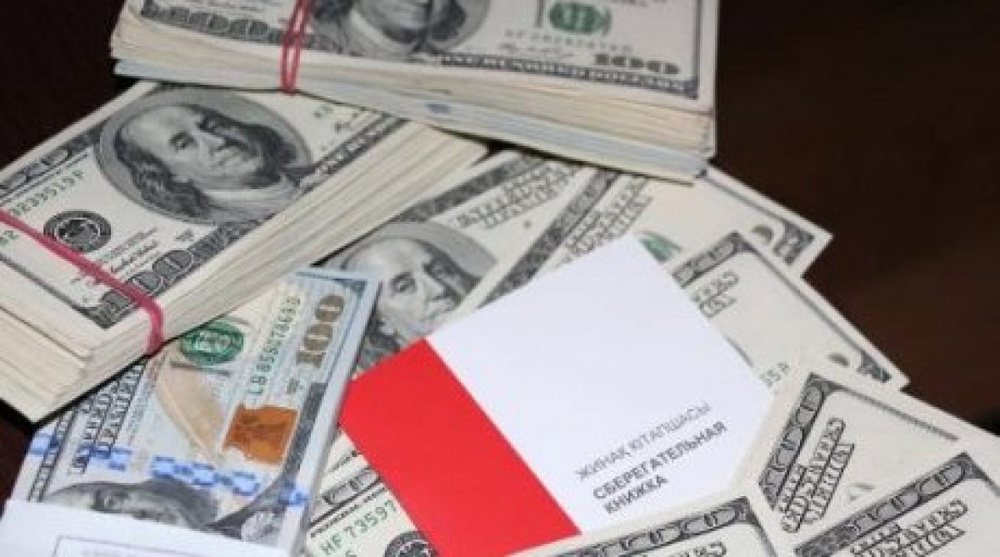
The February 2011 decision of the National Bank of Kazakhstan to release the Tenge in the "managed" free float abolishing the trading corridor has brought Kazakhstani depositors to loosing 20% of their savings in dollar equivalent, Tengrinews reports citing Milllioner magazine.
As of the end of 2013, according to the official statistics, the deposits kept in tenge amounted to $34.3 billion (6317 billion tenge). On the grim day of the tenge devaluation - February 11, 2014 - they were axed by $6.8 billion (1263 billion tenge).
Despite the urges of the National Bank to deposit money in tenge, there are no measures to support Kazakhstani depositors who are keeping their deposits in tenge. Consequently, the tenge deposits turned out to be a loosing deal. Devaluation amounted to 20% while the annual interest rate at the Kazakhstan tenge deposit market has not exceeded 9.4%.
Meanwhile, according to the calculation made by Megapolis, Kazakhstanis have lost far more than that. It has estimated the losses at 324 billion tenge ($1.75 billion) . The calculations are based on the following statistics.
In 2013, time deposits in tenge reached $11.3 billion (growing 5.5% in 2013) in Kazakhstan and the deposits in foreign currencies (mostly US Dollar) reached $10.7 billion (growing 31% in 2013). The growth difference is immense and it shows a huge mistrust to the national currency in Kazakhstan. Even more so, since it was happening against the background of foreign currencies deposits interest rates being lowered to 4.7-4.5% and those on tenge deposits increased to 8.3-8.1%.
On February 11, 2014, the governor of the National Bank of Kazakhstan Kairat Kelimbetov announced a one step devaluation of tenge away from the previous rate of 155 tenge per dollar to the new weighted average of 185 tenge per dollar. “The National Bank expects that the new exchange rate will be at around 185 tenge per US Dollar,” Kairat Kelimbetov said adding that the central bank will be supporting the nation currency and keeping it within the range of 182-188 tenge. Despite Kelimbetov’s order, many commercial banks of Kazakhstan ignored the exchange rates determined by the National Bank of Kazakhstan.
For many Kazakshtanis the decision of the National Bank came like a thunderbolt. On The Black Tuesday, as many Kazakhstanis are no calling it, large malls and online shopping websites were closed along with a number of exchange offices. The dollar was sold and bought for more than 200 tenge.
The Prime Minister of Kazakhstan Serik Akhmetov ordered to take step to keep the citizens from falling into frenzy out of fear of the increase of the cost of living and outrage at the loss of a portion of their incomes and saving to the devaluation of tenge.






The February 2011 decision of the National Bank of Kazakhstan to release the Tenge in the "managed" free float abolishing the trading corridor has brought Kazakhstani depositors to loosing 20% of their savings in dollar equivalent, Tengrinews reports citing Milllioner magazine.
As of the end of 2013, according to the official statistics, the deposits kept in tenge amounted to $34.3 billion (6317 billion tenge). On the grim day of the tenge devaluation - February 11, 2014 - they were axed by $6.8 billion (1263 billion tenge).
Despite the urges of the National Bank to deposit money in tenge, there are no measures to support Kazakhstani depositors who are keeping their deposits in tenge. Consequently, the tenge deposits turned out to be a loosing deal. Devaluation amounted to 20% while the annual interest rate at the Kazakhstan tenge deposit market has not exceeded 9.4%.
Meanwhile, according to the calculation made by Megapolis, Kazakhstanis have lost far more than that. It has estimated the losses at 324 billion tenge ($1.75 billion) . The calculations are based on the following statistics.
In 2013, time deposits in tenge reached $11.3 billion (growing 5.5% in 2013) in Kazakhstan and the deposits in foreign currencies (mostly US Dollar) reached $10.7 billion (growing 31% in 2013). The growth difference is immense and it shows a huge mistrust to the national currency in Kazakhstan. Even more so, since it was happening against the background of foreign currencies deposits interest rates being lowered to 4.7-4.5% and those on tenge deposits increased to 8.3-8.1%.
On February 11, 2014, the governor of the National Bank of Kazakhstan Kairat Kelimbetov announced a one step devaluation of tenge away from the previous rate of 155 tenge per dollar to the new weighted average of 185 tenge per dollar. “The National Bank expects that the new exchange rate will be at around 185 tenge per US Dollar,” Kairat Kelimbetov said adding that the central bank will be supporting the nation currency and keeping it within the range of 182-188 tenge. Despite Kelimbetov’s order, many commercial banks of Kazakhstan ignored the exchange rates determined by the National Bank of Kazakhstan.
For many Kazakshtanis the decision of the National Bank came like a thunderbolt. On The Black Tuesday, as many Kazakhstanis are no calling it, large malls and online shopping websites were closed along with a number of exchange offices. The dollar was sold and bought for more than 200 tenge.
The Prime Minister of Kazakhstan Serik Akhmetov ordered to take step to keep the citizens from falling into frenzy out of fear of the increase of the cost of living and outrage at the loss of a portion of their incomes and saving to the devaluation of tenge.




 +7 (777) 001 44 99
+7 (777) 001 44 99















































